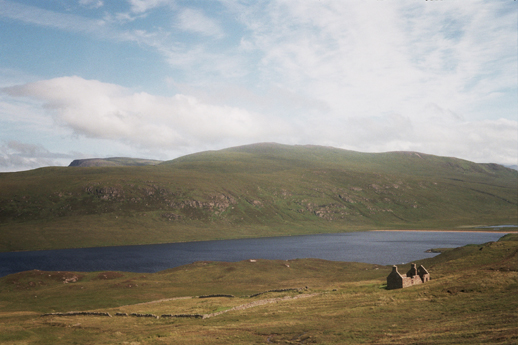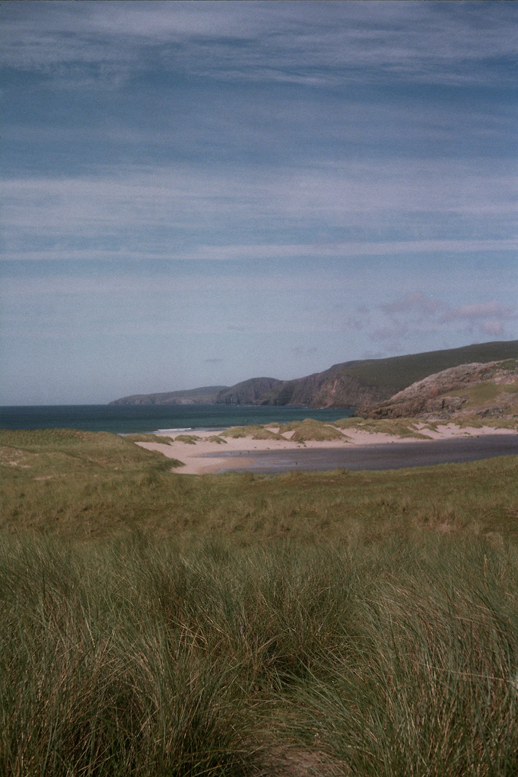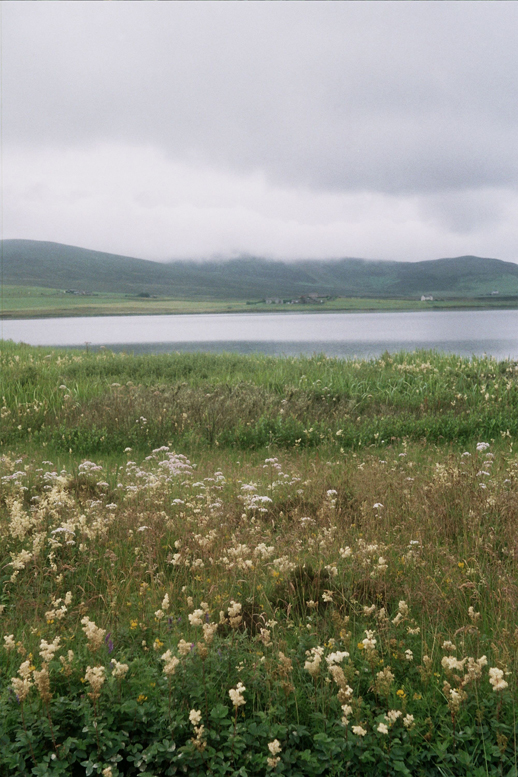Words and pictures by Rob St. John.
The gale in Sandwood Loch gathered quickly after a long walk in still, cleansing sunlight. Our route along leaning moorland paths was lined with orchids lapping up the rewards of another damp summer. The boil and bluster of the onshore gusts through the narrow Sutherland valley forced my lightweight fly rod into a bent, serpentine whine, calling a premature end to the planned day of fishing and lounging in the sunshine. My girlfriend and I retreated from the water and sat amongst the bracken and heather, peeking over our still, green hollow at white-tipped waves cantering onto the shoreline. Otter prints traced minimal, liminal paths between the loch and gritted shore. We cooked monkfish – gifted by a trawlerman on Kinlochbervie pier – over a blackened Trangia and scattered a few chunks as offerings to the otters. As we picked our way uneasily back across the damp moorland, our bodies billowed in the wind like trembling, tongueless bells, hardly able to speak across the growing swell of sound.
We had been arcing a slow sextant swing northeast across the highlands and islands of Scotland: writing, fishing and walking. Despite our best efforts, we had yet to fool a loch trout on an assortment of flies better suited to Lancastrian limestone rivers and nocturnal sea trout. There was the clear, still day on Kirbister Loch on mainland Orkney, where trout rose freely to tiny black flies, yet studiously ignored even the most minute imitations. On the calm, still water, every failed cast felt fruitless, as my rusty, fluffed offerings (a decent description of both my casting ability and my neglected fly box) landed on heavy, tangled tangents. If only for the comfort of home routes – the mapped and memorised runs of the tumbling Hodder and Ribble – spates you can trace in the dark.
A few weeks and another ferry trip north brought me to Loch Asta, which sits in a glacial valley that emerges at Scalloway on the west side of mainland Shetland. As I walked through the buzz-cut fields separating the loch from the single track road, arctic terns arched and arrowed above the surface of the water’s surface, as if attracted and repelled in equal measure by the loch’s metallic, monochrome sheen: dwindling flocks tracing flight paths towards the magnetic north. A pair of oystercatchers wheeled and turned through the narrow valley, their quickening call the melody to the motorik thrum and hum of two wind turbines turning above the loch. The longer draw of a curlew’s song emerged anonymously from somewhere amongst the purple water mint along the water’s edge, dipping between the oystercatchers’ top notes and broken only by a kid on a quad bike on the hill above, unceremoniously screaming for his sheep to ‘get in the fucking fold’.
I false cast through the still, heavy air, sending loops of line a little clumsily (an emerging pattern here) onto the gentle ripples of the shallow, peat-stained loch. Each false cast left a path: a trace memory through the air ever thickened by a freshening front of drizzle and mist. Wrist still, forearm straight, I attempt to run through half-remembered guidance. I’m soon lost in the staccato strip of the line drawn to the waltz-time procession of an unfinished song I’m turning over in my head, leading the submarine flies in a lopsided step.
The orthodoxy amongst most fly fishermen is to keep false casts to a minimum: they disturb fish, tangle teams of flies and snag onto vegetation. I can’t always keep to this, often lost in the hypnotic minimalism of a well-weighted fly line arcing back and forward through the air, before a final letting go. False casts like new thoughts: teasing ideas, actions, words through your mind: each decision tentatively tried out before committing. The meditative hum of a line careering smoothly through the rod rings, the slow anticipatory spread of ripples as a team of flies lands softly on the water. Anticipation fades through faint hope and imperceptibly slips awash into the realisation that the fish perhaps aren’t in the mood.
This continuous, repetitive set of actions – cast, retrieve, cast, retrieve – helps clear your head for daydreaming, scheming and imagining. Ideas and plans ripple out like the dots around my waterlogged offerings, slowly retrieved, turned over and false cast: places to live and work; creative projects to take on or quietly abandon; how to keep a life in freelance art afloat in increasingly difficult times.
Suddenly, this repetitive reverie is punctuated by a splash and a sharp tug on my line. I miss the take completely, leaving a wake and length of limpid line shivering on the loch’s surface. There’s a slight element of farce in every missed take, much like a cat falling off a chair, your first instinct is to wonder how you got into this daft pose, with loops of line hanging inert from a rod at a jaunty angle, and then to quickly glance around to see if anyone noticed. Safe from scrutiny, I retrieve, check over the line and begin to false cast again into the darkening evening. Another walk, to another ferry and then on to another loch where I can get lost for a while.


